In an effort to address a lack of housing that officials say has contributed to a shrinking teaching workforce, the California Department of Education is planning on converting undeveloped school lots into affordable housing.
State Supt. of Public Instruct. Tony Thurmond said the plan could potentially create 2.3 million new housing units on 75,000 acres of land owned by local educational agencies statewide.
“California’s housing crisis is undeniable, but it is not unsolvable,” Thurmond said in a statement. “We know that families across our state are impacted, from the homelessness crisis facing our urban areas, to the long commute times impacting families priced out of once-affordable neighborhoods, to the staffing crisis in schools whose educators can’t afford to live where they work.”
The proposed new homes would address more than 90 percent of the state’s 2.5 million housing shortfall, according to Thurmond.
Eligible residents include teachers and staff such as custodians, food service workers, bus drivers, and special education aides. The program also promises to offer rents 50 percent lower than market rates.
According to a 2021 study by the University of California, Los Angeles and U.C. Berkeley, over one-third of public school employees are “rent-burdened,” meaning housing costs consume more than 30 percent of their income. The issue is particularly severe for food service workers, more than half of whom are affected.
To tackle the issue, Thurmond said that increasing the availability of affordable housing is key, as shortages directly affect overall housing costs.
Housing difficulties have led many teachers to either relocate to cheaper areas within the state or leave altogether. In recent years, public schools have lost an average of 12 percent of their teachers annually, according to the study.
“We have teachers that have commutes well over 100 miles. They’re sitting in their cars for hours every morning and every evening,” California Federation of Teacher’s legislative director Tristan Brown said during the press conference.
Additionally, the superintendent, as well as the study, said staffing challenges are impacting students.
High teacher turnover leads to less consistency in teaching and relationship building, which is linked to lower student achievement, particularly in English Language Arts and math, the study said.
Thurmond said that to help students thrive, the state must first take care of its teachers, which would, in turn, help keep students enrolled.
“We see this as a way to attract and support educators. We see this as a way to offset declining enrollment that our schools are facing,” he said.
But, he said that the decline in public school student enrollment over the past several decades, and especially since the COVID-19 pandemic, has left many schools’ infrastructure and resources underutilized, which can now be repurposed.
Currently, local school districts own approximately 150,000 acres of land statewide, and the study identified around 75,000 acres of unused land that’s potentially suitable for housing development. Five projects are finished, and four are in progress.
Jefferson Union High School District, near San Francisco in San Mateo County, is one of the pioneers in building teacher housing.
In 2022, the school district opened a 122-unit housing project, which houses about 25 percent of its staff. Trustee Andy Lie said its reduced turnover from 25 percent to zero vacancies.
“The staff morale is up. But most importantly, we can’t give our best to our students if our educators are struggling with housing insecurity,” Lie said. “We now can continue to build on our curriculum because our staff are sticking around.”
Los Angeles Unified School District, the second-largest school district in the U.S., developed three housing projects between 2014 and 2017, totaling 185 units. Additionally, the district is considering nearly a dozen potential sites for future housing development.
“We live and work in a very expensive area in this country,” LAUSD Supt. Alberto Carvalho said. “Our ability to recruit, retain, and incentivize our workforce hinges in part, not only on compensation and benefits, but also the ability of our workforce to live in the communities where they teach and where they work.”
Districts can finance projects using local bonds and state tax credits, including $500 million allocated for educator housing in the 2020 state budget. The Jefferson Union project, for example, secured a $33 million bond in 2018.
According to Thurmond, districts can either lease the land to developers or choose to sell it.
“Districts that are struggling financially have found this to be an asset that has great marketability and that they can use to help address their financial bottom lines,” he said.
Besides securing financing, Thurmond said that the education department works with local jurisdictions to ensure zoning and permitting flexibility. At the state level, Gov. Gavin Newsom signed a law in 2022, which allows housing construction on school-owned land.
“Until we can pay teachers and classify staff better, building affordable housing for them is an important tool for educator recruitment and retention,” Thurmond said.
















